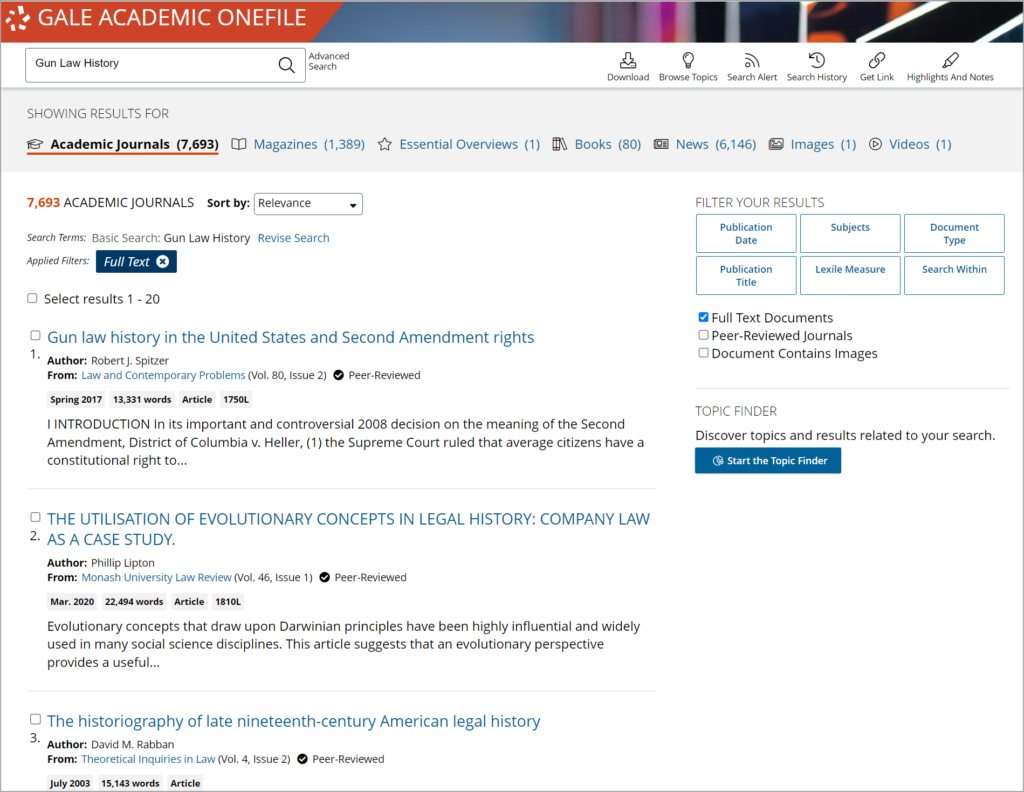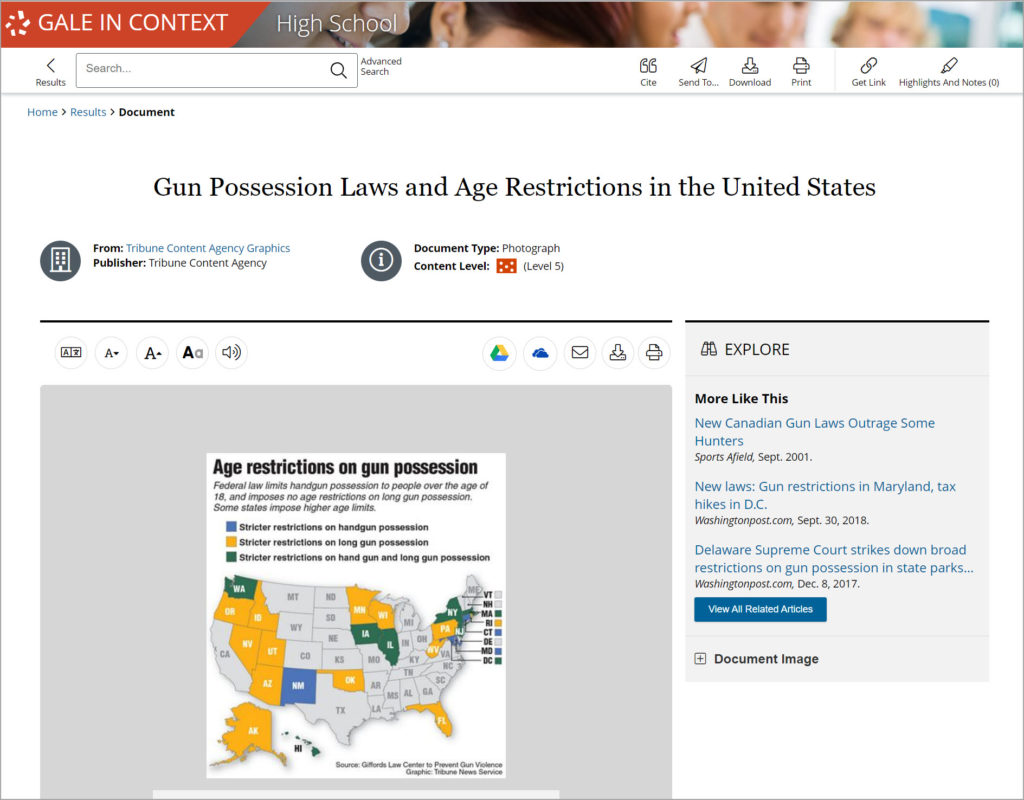Since before the 1791 Bill of Rights ratification to the Constitution, in which the second amendment provided the right to keep and bear arms, gun laws have been debated. Some think the second amendment was created for individual citizens, while others believe it was designed to protect the government.
Before students begin their research, suggest Gale In Context: Opposing Viewpoints as a starting point. The pages are updated daily, easy to navigate, and students get a chance to develop their critical-thinking skills.
For small group activities, professors can assign specific gun laws for the groups to research in Gale Academic OneFile, giving them access to thousands of resources, including journals, magazines, podcasts, and transcripts from major news agencies. Academic students can research red flag laws from the first adoption in 1999 to the future of red flag laws within one article. You can also encourage students to look at the history of concealed carry laws, including the age limit for concealed carry permits, from the early 1980s to today. Gale Academic OneFile contains plenty of scholarly articles on concealed carry to fuel your academic students’ research.

Research Gun Laws with Credible Sources
Examples of research topics include the 1934 National Firearms Act and the 1938 Federal Firearms Act passed by President Franklin D. Roosevelt. Students can learn more about all presidents in the Gale In Context: Biography portal using video, audio, photos, newspapers, and periodical archives.
The next significant gun law to be passed occurred in the 1960s when the assassinations of Martin Luther King, Jr., President John F. Kennedy, and Senator Robert F. Kennedy devastated the world. Firearms were used in each violent crime, which led President Lyndon B. Johnson to pass the Gun Control Act of 1968.
The Brady Handgun Violence Prevention Act was another primary gun law enacted by President Bill Clinton in 1993. Brady represents the first major federal legislation on gun control since the 1968 Gun Control Act. Named after President Ronald Reagan’s Press Secretary, James Brady, who was shot by a bullet while protecting the president during an assassination attempt, it led to the implementation of the Federal Bureau of Investigation’s criminal background check system. Gale Academic OneFile provides hundreds of scholarly articles on gun laws for your academic students.
Military-style assault weapons owned by civilians are the focus of many conversations today. Students can research the pros and cons of banning assault weapons and discuss them with their classmates. They may be interested to learn that from 1994 to 2004, President Clinton passed the Federal Assault Weapons Ban. This law prohibited the manufacturing, selling, or possessing assault weapons and ammunition magazines that could hold more than ten rounds.
More recently, the gun bill 2022 was passed to end the reign of mass shootings, with 15 Republican senators joining every Democrat in support. This gun bill 2022 offers new funding supporting states and tribes that seek to enact red flag laws—which allows authorities to confiscate guns from individuals deemed a threat to themselves or others—closing the so-called boyfriend loophole, and subjecting gun purchasers under the age of 21 to new background check requirements.
At a state level, California Governor Gavin Newsom signed a set of gun safety bills into law amid an increase in shootings in July 2022 that require more regulations on gun sales and dealers within the state as well as increased information sharing between schools and law enforcement agencies.
Navigate Resources on the Supreme Court
As students navigate and dive deeper into this research, they will learn about The Supreme Court and its influence in shaping gun laws. Researchers can learn about the Supreme Court, the justices, legislation, and the significance of judicial review. They will discover the 2008 history-making ruling in District of Columbia v. Heller that the right to bear arms is an individual right to own a firearm that isn’t connected to military service.
This ruling was followed by the 2010 case of McDonald v. Chicago, the 2016 case of Caetano v. Massachusetts, and the 2022 case of New York State Rifle and Pistol Association v. Bruen. In all cases, the Supreme Court Justices ruled in favor of the individuals and their rights under the second amendment. But the second amendment does not apply to everyone. The Supreme Court clarified that there are strict restrictions and standards for possessing a firearm legally.
Send students on a digital hunt in Gale OneFile: News. Here, they can sift through thousands of newspapers and media files to discover lesser-known cases involving the second amendment. They can also search the eligibility requirements for the right to bear arms to find out if they meet them or not.
Explore State vs. Federal Laws
For a quick project on how state laws are different or the same as federal laws, assign each student a state. High school students can research gun laws and compare their findings. Gale In Context: High School offers scholarly articles on concealed carry, criminal laws, and more! They can answer questions like:
- “How old must you be to own a gun in your state?”
- “Can criminals own a gun in your state?” “
- Do you have to be a citizen of the United States to own a gun?”
- “Can people with a mental illness possess and carry a gun?”
- “What are red flag laws?”
- “What is the age limit for concealed carry permits?“

As trends occur in society, they affect state and federal gun laws. Give students an extra credit project to compare state and federal gun laws with what was going on locally, nationally, and around the globe when the law was enacted. Gale In Context: High School allows students to search by subject, or for this project, by gun laws.
Discover Opportunities for Subject Integration
With a topic like gun law history, many opportunities exist for integrating relative subjects. Spending time in Gale In Context: Opposing Viewpoints will help high school students discover topics that connect to gun laws and how they affect society today. For example, the portrayal of guns in movies and their effect on pop culture. Other niches may include gun violence in schools, crime rates, gun trafficking, domestic violence, self-defense, mental health, or what role the Fourteenth Amendment plays.
Not a Gale resources subscriber? Contact your rep today!

